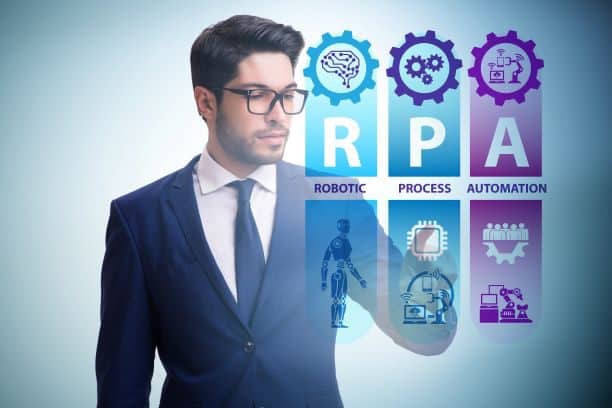
By using software robots, Robotic Process Automation (RPA) frees employees and managers from repetitive and time-consuming digital tasks. Today, RPA is evolving towards hyperautomation. Thanks to artificial intelligence, they can now automate complex tasks, process unstructured information and even make decisions.
RPA. Three letters synonymous with productivity. Robotic process automation involves automating as many repetitive, time-consuming and non-value-adding digital tasks in an organisation as possible.
To do this, software robots will reproduce the sequence of clicks or cut-and-paste operations that an employee performs manually at his or her workstation to collect and process information. Generally speaking, these are simple tasks, such as filling in forms, extracting data from a table or database, performing calculations, manipulating files and folders, and so on.
RPA improves efficiency
Thanks to RPA, the company will gain in productivity. Let's take the example of a bank. When a bank account is opened, a bot makes sure that all the supporting documents are in place. Another queries various databases to check that the new customer is not a prohibited bank customer. In this way, the company gains in operational efficiency while reducing the risk of human error or non-compliance.
Automation brings other benefits. By automating its back office processes, an organisation is less dependent on the presence of its staff on site and gains in resilience. According to the same Gartnerthe RPA market will have jumped by almost 39 % by 2020 to reach 1.9 billion dollars. In France, 29 % of large companies and ETIs have already deployed this technology according to another studypublished by Mazars and UiPath, the market leader in RPA.
RPA was already a major trend with the health crisis, and the Covid-19 pandemic only accentuated the need for companies to automate their processes more and more. RPA is evolving towards hyperautomation. This term was coined by the American consultancy firm Gartner, which identified it as one of the most important areas for the future. nine technological trends of 2021.
From RPA to hyperautomation
RPA is therefore part of a wider movement towards hyperautomation, which calls on various technological building blocks, the main one being artificial intelligence.
Upstream of the processing chain, optical character recognition (OCR) extracts the relevant data from a document such as an order form or invoice. The RPA's software robots then match this data to other data, while the OCR system matches the data to the document. machine learning will add a layer of artificial intelligence.
A hyperautomation solution can also make use of business process management (BPM) and the low code/no code approach. This is known as Robotic Desktop Automation (RDA). By using application design platforms that require little or no code, business experts can automate their own processes. A democratisation that makes sense. Finally, who knows better than operational staff which processes should be industrialised as a priority?
The range of processes eligible for automation has also expanded. After starting with accounting and financial operations, RPA has now moved on to support functions such as IT and HR. In the case of onboarding a new employee, bots will automatically trigger a badge request or create a profile in the company directory.
Who are the RPA specialists?
Specialists in this buoyant RPA niche include Automation Anywhere, Blue Prism and UiPath, the market leader. UiPath was valued at around 40 billion dollars when it was floated on the stock market in April. French company Contextor, meanwhile, has been acquired by SAP. Coming from the world of Business Process Management (BPM), players such as Appian and Pega also have a legitimate claim to a place in process automation.
Nor could the digital giants remain aloof from the phenomenon. Google Cloud has teamed up with Automation Anywhere and AWS has forged partnerships with Blue Prism and UiPath. With Power Automate, Microsoft is offering its own hyperautomation platform, combining low-code, RPA and artificial intelligence components.
Microsoft is also offering a client version of its solution for business specialists who are not IT specialists. Downloadable free of charge, Power Automate Desktop (PAD) enables users to automate a series of personal tasks directly from their workstation. It's a practical way of democratising RPA.
For example, you could receive an e-mail containing a list of your next appointments, automatically analyse tweets and transmit the results to a Power BI dataset, or create a task as soon as you are mentioned in an e-mail.
What impact will RPA and hyperautomation have on companies?
At company level, however, the deployment of RPA is not neutral. By attacking potentially structuring processes, a project of this type can have an impact on the organisation of work and therefore on employment. While it is often said that robots free employees from tedious tasks, the scope of their work may be altered as a result.
The HR department will therefore be involved at an early stage in order to assess the social impact of automating a process and, if necessary, put in place training or even retraining measures if jobs are eliminated by RPA.
In terms of governanceTo achieve this, the company needs to set up a steering committee involving the IT and business departments to define the objectives and associated use cases. In addition to productivity gains, RPA can also improve customer relations and enhance the employee experience.
Some large companies, mature in this area, have industrialised the approach, with dozens of robots in production. To do this, they have set up a Centre of Excellence (CoE), which may have different names. An RPA factory, a cognitive factory or an automation factory brings together different profiles, from robot developers to business experts.
All RPA projects go through this factory, which will be responsible for the quality, safety and maintenance of the robots developed. For the sake of consistency, this factory is generally attached to the IT Department, to ensure seamless integration with the company's information system.


